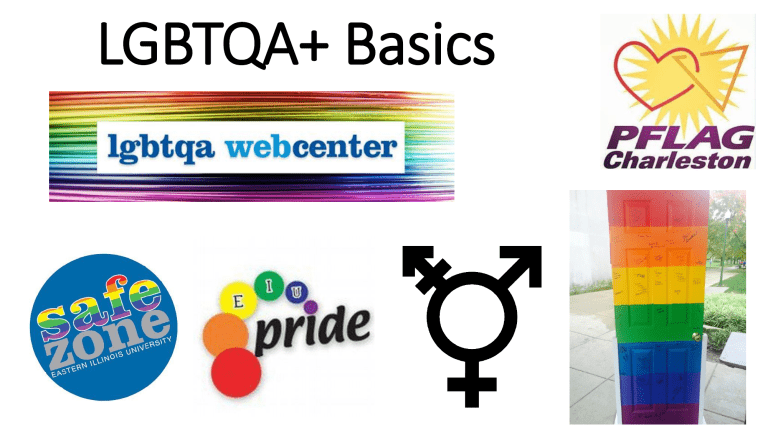LGBTQA+ Basics

LGBTQA+ Basics
•
Gay Pride Flag
Gay is a term used to describe people who are attracted to those of the same sex
•
Bisexual Pride Flag
Bisexuality is the attraction towards two genders.
Bisexuals may experience more attraction towards one or the other gender, they may not. Respect the labels people choose to use!
•
Lesbian Pride Flag
A Lesbian is a woman who is attracted primarily to other women
•
Pansexual Pride Flag
Pansexuality is the attraction towards all genders
Pansexuality is different from bisexuality because it includes all genders, not just two.
•
Asexual Pride Flag
Asexuality is the lack of sexual attraction. That being said, asexual individuals may decide to date depending on their romantic orientation.
•
Polysexual Pride Flag
The attraction to multiple genders.
Bisexuality and pansexuality are forms of polysexuality. Polysexuality generally rejects the idea of a gender binary, the idea that there are only two genders (male and female), rather than a spectrum of genders.
•
Transgender Pride Flag
Transgender refers to an individual whose gender identity does not match the gender assigned to them at birth.
How someone chooses to transition depends on the person. Not everyone decides to take hormones or receive surgery. Please respect people’s identities and pronouns that they tell you to use.
General rules of thumb: Do not ask a trans person about their genitals, how they have sex, or any other questions that would make you uncomfortable if you were asked them.
•
Agender Pride Flag
Agender individuals are those who identify as having no gender, being without any gender identity, or do not care about or know their gender identity
•
Genderqueer Pride Flag
Genderqueer is a gender identity that falls outside of the gender-binary.
Genderqueer people may express a combination of masculinity and femininity, or neither, in their gender expression.
ALWAYS respect the pronouns you are asked to use!
•
Non-Binary Pride Flag
Non-binary describes any gender identity which does not fit within the binary of male or female.
Non-binary identities you can research further: genderqueer, genderfluid, agender, demigender, bigender, third gender, androgyne, plus many more!
•
Intersex Pride Flag
Intersex refers to a person whose sexual anatomy or chromosomes do not fit with the traditional markers of "female" and "male.“
ALWAYS respect the pronouns you are asked to use.
•
Genderfluid Pride Flag
Genderfluid individuals have different gender identities at different times. Gender can vary or flow from one day to the next.
ALWAYS respect the pronouns you are asked to use,
•
Aromantic Pride Flag
Aromantic refers to individuals who do not experience romantic attraction. Aromantic and
Asexual are NOT synonomous.
•
•
Gender & Sexual Minority
(GSM)
GSM is a simpler, more inclusive way to refer to the LGBTQA+ community.
As you can see, there are many identities, and many people dislike being lumped into the “+.”
Gender Identity
One's personal experience of one's own gender. It is internal and deeply rooted in one’s sense of self. This is personal and does not necessarily have a correlation with gender expression.
•
Romantic Orientation
Refers to an individual's pattern of romantic attraction based on a person's gender.
This is considered distinct from sexual orientation, which refers specifically to a person’s patterns of sexual attraction.
•
Gender Expression
Gender expression is the way in which you express your gender, so through your clothes, hair, and other elements of style. One’s gender identity will not always be reflected in one’s gender expression.
• Queer
Queer was used in a more derogatory manor historically, but has been reclaimed by the LQBTQA+ community. Some people use “queer” as a way to describe their sexuality and/or gender identity.
•
Cisgender
Refers to someone whose gender identity matches the gender they were assigned at birth
•
Drag
Drag refers any clothing carrying symbolic significance but usually referring to the clothing associated with one gender role when worn by a person of another gender
• Outing
Sharing that someone is LGBTQA+ without their permission. It is not uncommon for people to keep their identities a secret for safety reasons, so always ask if it is okay to share before doing so!
• Coming Out
A process in which an
LGBTQA+ individual will share elements of their identity with others. Coming out is an ongoing process that never really ends since new people are constantly being met. Not all individuals come out for various reasons. ALWAYS be respectful if someone comes out to you- it might have been very scary for them!
Instructions for Bulletin Board
• All pride flags are next to their definitions
• The image here is an example of one way this bulletin board can be done
• If there is anything you do not understand on this board, please ask the LGBTQA
Resource Center. A quick google search is a possibility as well, but it might not be as thorough.
• Thank you for using this bulletin board!
Bulletin Board put together by Lauren Eberle, Social Co-Chair of EIU Pride, 2015-2016
This page is meant as info for the user only.
It is not apart of the bulletin board and does not need to be printed.








